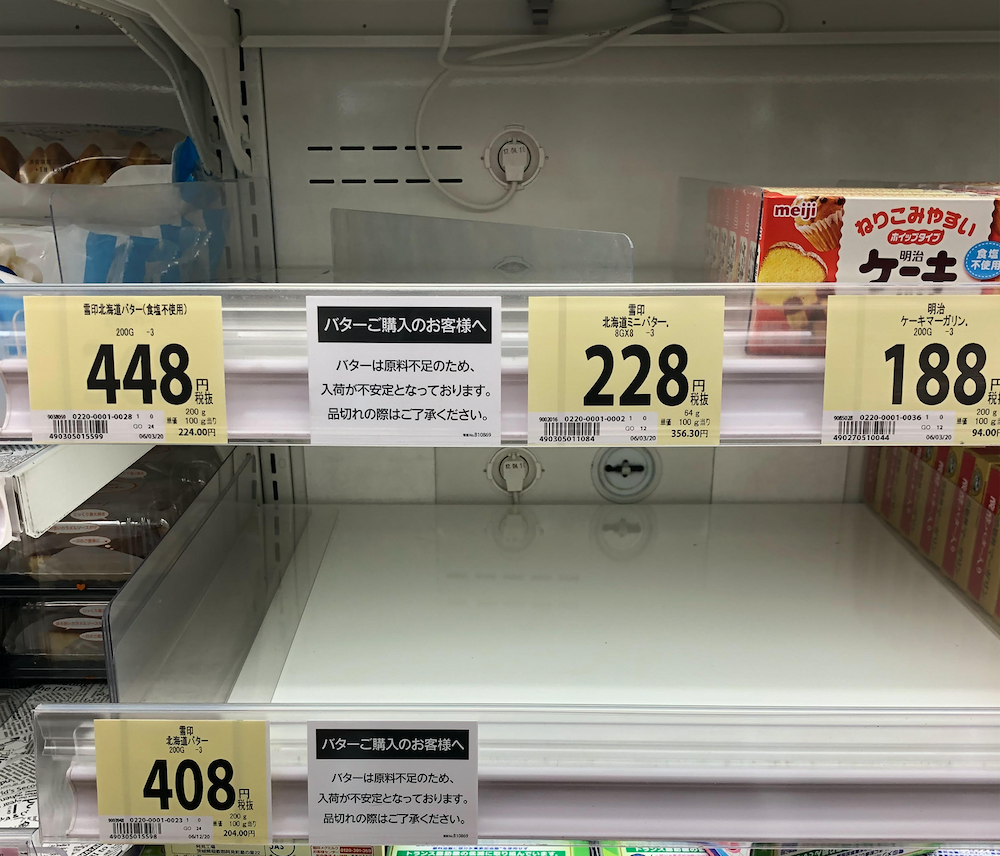
By Mao Shiotsu
Ever since I produced my first tray of shortbread biscuits ten years ago, I’ve been baking almost every weekend. Being quarantined at home has only escalated my obsession. Now I bake multiple times every day, much to the delight of my family who seem to be plumping up by the day.
So it’s quite troubling that the dairy aisle of all four supermarkets within a one mile radius of my Tokyo home have been butterless these past few weeks. All that sits atop the sad shelves are passive-aggressive notes that read, “One block per person. We do not know when butter will be restocked. Don’t ask us.”
As much as I like the butter-free, guilt-free flavors of raspberry soufflé and grapefruit jelly, they can’t excite my taste buds like the salty, buttery flakes of a croissant, or the tight, yet tender crumb of a yellow cake. I’ve discovered that the only way I can get my hands on a block of butter is going to the 24-hour supermarket at 7AM sharp, before anyone else gets there (I once managed to snag four blocks using this method and swiftly did self-checkout so nobody could tell me off, hurrah).
But why must I drag myself out of bed at 6:45AM, simply to buy a block of semi-solid dairy emulsion? COVID-19 highlighted Japan’s butter shortage, but it has been a scarce resource before the pandemic, too. A 200g block (around two sticks) costs a whopping 450 yen (4 dollars). There’s plenty of milk, so it seems strange that there’s no butter. Hence I did a little digging.
Only 40% of food in Japan is nationally produced. Japan is a geographically small country, and a lot of the land is unsuitable for farming. The farming industry has also been declining steadily in the past decades. Yet in 2015, almost all the butter in Japan was produced nationally in Hokkaido, the northernmost region of the country. The government seems bent on protecting national dairy producers, supporting them with policies like a subsidy system that neither the EU nor the US have, and, until 2016, controlling almost all butter production and distribution in the country through the ten regional Japan Agricultural Cooperatives.
However, with the escalating shortage, Japan has started to take a more open stance towards importing butter. In 2016, for example, it agreed to a Trans-Pacific Partnership pact to lower tariffs on dairy products, which encourages more —yet still limited— imports from New Zealand and Australia. Admittedly, though, the effects of these new efforts aren’t very evident.
But if masses of imported butter starts freely streaming into the Japanese dairy market, the cheaper, more abundant foreign blocks will most likely push small-scale Japanese farmers out of business. And with Japan’s food self-sufficiency already being one of the lowest amongst advanced economies, and the pandemic leaving farmers jobless, that’s something we really want to avoid.
It’s difficult to say that the protection of national industries is a valid excuse for denying the public butter. But the next time I’m faced with an empty butter shelf, beneath my anguish of not being able to bake flaky croissants, at least I’ll detect a twinge of comfort in knowing that my croissant deprivation might actually be protecting Japanese dairy farmers.
Mao Shiotsu is a rising sophomore in Jonathan Edwards College. You can contact her at mao.shiotsu@yale.edu.